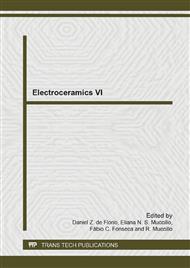[1]
H. Allik, T. Hughes, Finite element method for piezoelectric vibration. Int. J. Numer. Meth. Engng. 2 (1970) 151–157.
DOI: 10.1002/nme.1620020202
Google Scholar
[2]
N. Guo, P. Cawley, D. Hitchings, The finite element analysis of the vibration characteristics of piezoelectric discs. J. Sound. Vibr. 159(1) (1992) 115-138.
DOI: 10.1016/0022-460x(92)90454-6
Google Scholar
[3]
IEEE Standard on Piezoelectricity, ANSI/IEEE Std 176 (1987).
Google Scholar
[4]
L. San Emeterio, P. Sanz, A. Ramos, Influence of dielectric losses on the shift of the fundamental frequencies of thickness mode piezoelectric ceramic resonators, J. Eur. Ceram. Soc. 19 (1999) 1165-1169.
DOI: 10.1016/s0955-2219(98)00393-8
Google Scholar
[5]
G. Nader, E.C.N. Silva and J.C. Adamowski, Effective damping value of piezoelectric transducer determined by experimental techniques and numerical analysis, ABCM Symposium Series in Mechatronics, 1 (2004) 271-279.
Google Scholar
[6]
S. Sherrit, T. Masys, H. Wiederick, B. Mukherjee, Determination of the Reduced Matrix of the Piezoelectric, Dielectric, and Elastic Material Constants for a Piezoelectric Material With C¥ Symmetry, IEEE Trans. Ultrason. Ferroelectr. Freq. Control, 58 (2011).
DOI: 10.1109/tuffc.2011.2008
Google Scholar
[7]
T. Lahmer, M. Kaltenbacher, B. Kaltenbacher, R. Lerch, E. Leder, FEM-based determination of real and complex elastic, dielectric, and piezoelectric moduli in piezoceramic materials, IEEE Trans. Ultrason. Ferroelectr. Freq. Control, 55 (2008).
DOI: 10.1109/tuffc.2008.664
Google Scholar
[8]
N. Perez, M.A.B. Andrade, F. Buiochi, J.C. Adamowski, Identification of elastic, dielectric, and piezoelectric constants in piezoceramic disks , IEEE Trans. Ultrason. Ferroelectr. Freq. Control. 57 (2010) 271-279.
DOI: 10.1109/tuffc.2010.1751
Google Scholar
[9]
S. J. Rupitsch, F. Wolf, A. Sutor, R. Lerch, Reliable modeling of piezoceramic materials utilized in sensors and actuators, Acta Mech. 223 (2012) 1809-1821.
DOI: 10.1007/s00707-012-0639-7
Google Scholar
[10]
U. Jonsson, B. Andersson, O. Lindahl, A FEM-based method using harmonic overtones to determine the effective elastic, dielectric, and piezoelectric parameters of freely vibrating thick piezoelectric disks, IEEE Trans. Ultrason. Ferroelectr. Freq. Control 60 (2013).
DOI: 10.1109/tuffc.2013.2555
Google Scholar
[11]
S. Li, L. Zheng, W. Jiang, R. Sahul, V. Gopalan, W. Cao, Characterization of full set material constants of piezoelectric materials based on ultrasonic method and inverse impedance spectroscopy using only one sample, J. Appl. Phys., 114 (2013).
DOI: 10.1063/1.4821107
Google Scholar
[12]
N. Pérez, M.A.B. Andrade, R.C. Carbonari, J.C. Adamowski, F. Buiochi, Accurate determination of piezoelectric ceramic constants using a broadband approach, in Proc. of JASA Meetings on Acoustics 19 (2013).
DOI: 10.1121/1.4799296
Google Scholar
[13]
J. Nelder, R. Mead, A simplex-method for function minimization, Comp. J. 7 (1965) 308-313.
Google Scholar


